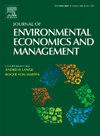Individual versus group-level agglomeration bonuses to conserve biodiversity
IF 5.9
3区 经济学
Q1 BUSINESS
Journal of Environmental Economics and Management
Pub Date : 2025-06-05
DOI:10.1016/j.jeem.2025.103193
引用次数: 0
Abstract
Agglomeration bonuses (ABs) are payments conditional on the contiguity of landowners’ conservation areas. We study whether differentiating the bonuses between internal (within-landholding) and external (between-landholdings) boundaries can improve biodiversity conservation. Using an ecological-economic model and game theory, our simulations on realistic landscapes consisting of several multi-plot landholdings reveal that such differentiation is key in determining AB cost-effectiveness. Undifferentiated ABs (where internal equal external bonuses) are the most cost-effective schemes when regulators’ budgets are low. Yet, when budgets increase, AB cost-effectiveness improves by increasingly prioritizing internal over external bonuses, until a budget threshold beyond which only internal bonuses remain. The complexity of compensation between plots belonging to different landowners largely explains these patterns. Given this complexity, the most cost-effective schemes are characterized by little or no cooperation between landowners. Regarding policy, we conclude that differentiated ABs are cost-effective schemes that should be part of the regulators’ toolbox.
保护生物多样性的个体与群体集聚奖励
集聚奖金(ABs)是根据土地所有者保护区的邻近程度来支付的。我们研究了区分内部(土地所有权内)和外部(土地所有权之间)边界之间的红利是否可以改善生物多样性保护。利用生态经济模型和博弈论,我们对由多个地块组成的现实景观进行了模拟,结果表明,这种差异是决定AB成本效益的关键。在监管机构预算较低的情况下,无差别资产证券化(内部和外部奖金相等)是最具成本效益的方案。然而,当预算增加时,AB的成本效益会提高,因为内部奖金比外部奖金更重要,直到超过预算阈值,只剩下内部奖金。不同土地所有者之间补偿的复杂性在很大程度上解释了这些模式。鉴于这种复杂性,最具成本效益的方案的特点是土地所有者之间很少或根本没有合作。在政策方面,我们得出结论,差异化ABs是具有成本效益的方案,应该成为监管机构工具箱的一部分。
本文章由计算机程序翻译,如有差异,请以英文原文为准。
求助全文
约1分钟内获得全文
求助全文
来源期刊
CiteScore
8.00
自引率
4.30%
发文量
91
期刊介绍:
The Journal of Environmental Economics and Management publishes theoretical and empirical papers devoted to specific natural resources and environmental issues. For consideration, papers should (1) contain a substantial element embodying the linkage between economic systems and environmental and natural resources systems or (2) be of substantial importance in understanding the management and/or social control of the economy in its relations with the natural environment. Although the general orientation of the journal is toward economics, interdisciplinary papers by researchers in other fields of interest to resource and environmental economists will be welcomed.

 求助内容:
求助内容: 应助结果提醒方式:
应助结果提醒方式:


